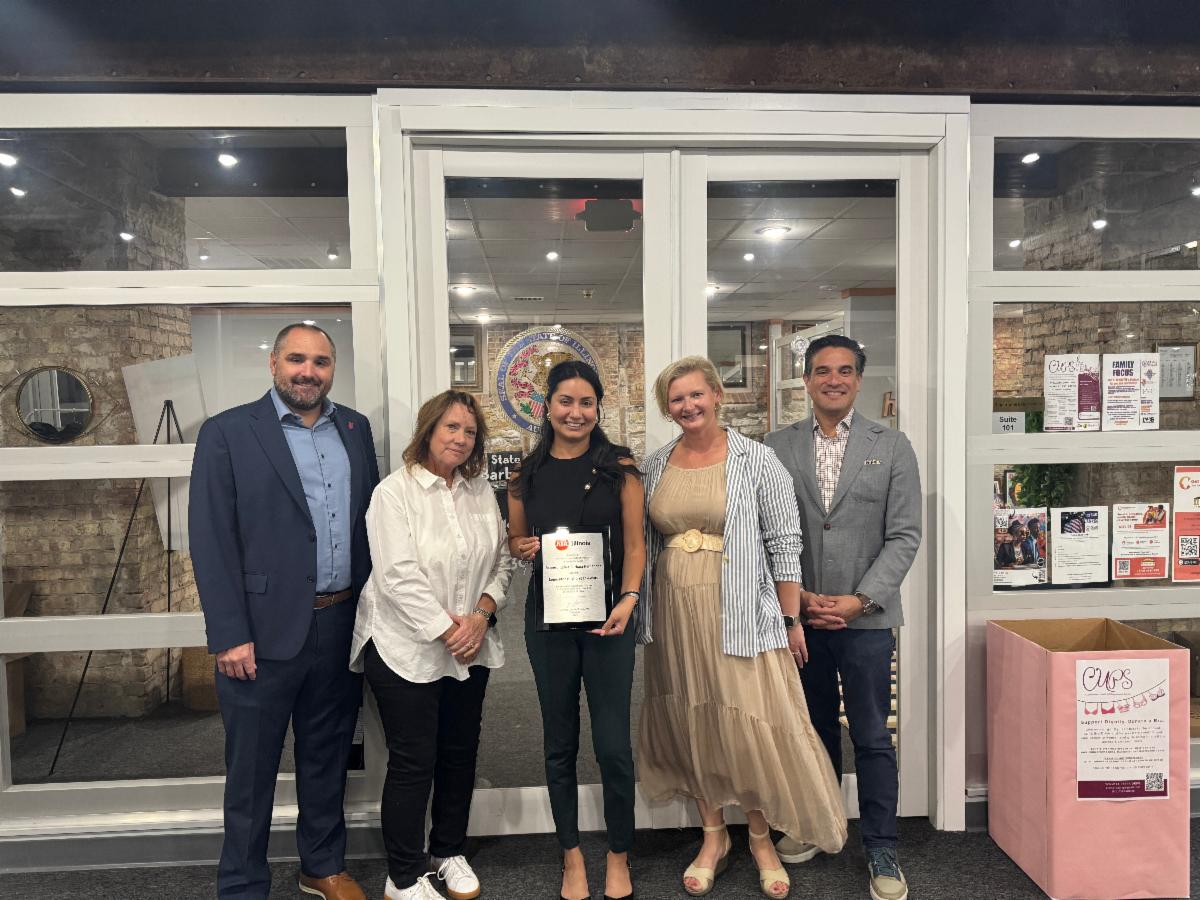Shaping the Future
AIA Illinois is Your Voice For Architectural Advocacy at The Capitol
Have a question about our advocacy work?
2025 Legislator OF THE YEAR
Members of the AIA Illinois board and the legislative committee recently gathered at Illinois State Rep. Hernandez’ office in Aurora to present her with a plaque and thank her on behalf of the AIA Illinois membership.
Rep. Barbara Hernandez works every day to provide a voice in the community for all residents through her work ethic, energy, and dedication to community service. She championed fair access to the architecture profession by helping to eliminate the 5-year cap on completing architecture exams which created unnecessary pressure, especially for individuals balancing work, caregiving, or financial constraints. By eliminating this restriction, she helped ensure that talented individuals aren’t excluded simply because their path doesn’t fit a narrow timeline.
Her support of eliminating the rolling clock opens doors for more diverse candidates to enter and thrive in the profession. Rep. Hernandez has consistently backed legislation that removes systemic barriers and promotes equity. She didn’t just sponsor a bill – her support will continue to help reshape the architecture profession to better reflect the diversity and resilience of the people it serves.
Thank you to Rep. Barbara Hernandez for her support with eliminating the rolling clock for architecture licensure in Illinois, and congratulations on being named the 2025 AIA Illinois Legislator of the Year.
Find Your Legislator

Citizen Architect
Being a citizen architect means recognizing that legislators are individuals with diverse backgrounds, interests, and concerns, just like any other member of the community. It entails engaging with policymakers to advocate for the safety, integrity, and advancement of the architecture profession while also contributing to the betterment of our built environment and infrastructure.
Ways To Get Involved
Meet With Your Legislators
Taking the initiative to meet with your legislators at their district offices, particularly in the context of vertical infrastructure funding and projects like the Capital Plan, offers an opportunity to serve as an industry expert resource. By discussing matters such as school safety, disaster recovery, and relief efforts, you can engage meaningfully in the legislative process and contribute to informed decision-making on architecture-related issues. Each year, AIA Illinois hosts Prairie Grassroots, where member architects meet with their legislators at the Illinois State Capitol to discuss topics like these!
Thank Your Legislator
A simple gesture like a phone call or a handwritten note expressing gratitude to your State Senator or Representative for supporting the Architecture Practice Act can make a meaningful impact. Demonstrating appreciation for their support is a professional and kind gesture that can foster stronger relationships.
Contribute
Supporting the AIA Illinois PAC through contributions is an essential way to actively engage with legislators and advocate for design-build policies that protect professional licensure and promote construction safety. Maintaining a robust PAC indicates strong membership interest in upholding industry standards.
Follow Along
Interested in the legislation that we are tracking? Follow along with us here. You can view all of the information that the legislature is considering and watch live hearings on the Illinois General Assembly website.
Pre-Qualification & Capitol Plan Project Bids
To ensure access to capital plan projects, architects, engineers, contractors, and sub-contractors are urged to undertake the qualification process through the Capital Development Board (CDB). The CDB provides invaluable free pre-qualification classes tailored for vendors interested in bidding on these projects. Emphasizing diversity, CDB serves as a pivotal resource for navigating the application and certification procedures, striving for project success through collaborative engagement with vendors.
QBS & Licensure
Embracing Quality Based Selection (QBS) and licensure not only upholds industry standards but also champions fairness, transparency, and excellence in architectural practices, serving as the cornerstone of our advocacy efforts to promote a thriving and ethical architectural landscape in Illinois.
Qualifications Based Selection (QBS) Process
Qualifications Based Selection (QBS) is a negotiated procurement approach centered on qualifications and competence tailored to specific project requirements. For further insights into this process, click HERE to learn more
Licensure Process
The Illinois Department of Financial and Professional Regulation (IDFPR) is the regulatory department for architects and engineers. Click HERE for more information on new licensees, license renewal, and out-of-state licensees seeking Illinois licensure.
Contribute to The Illinois Architects Political Action Committee
By contributing to IAPAC, you play a vital role in advocating for the architectural profession through positive lobbying efforts.
We encourage members to support IAPAC by donating the equivalent of one billable hour, strengthening our collective voice in shaping policies and regulations. Explore how your PAC dollars make an impact and extend your influence to the federal level by contributing to AIA National’s ArchiPAC.
To donate, you can use the secure link below or print and mail this paper form.




